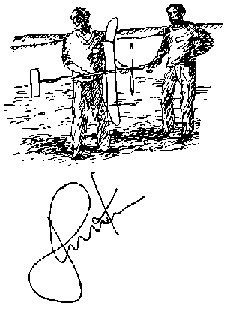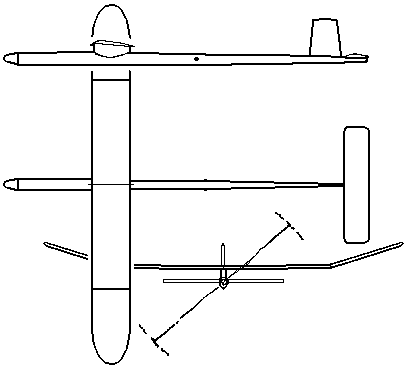Wakefield International Cup - A history from 1911 by Charles Dennis Rushing
1965 Thomas Koster, 18, Denmark
The venue this year was mid-Finland at Kauhava for the FFWC format consisting of the three FAI Free Flight events: glider F1A, rubber F1B, and power F1C. The village of Kauhava, has a population of only 10,000, and I am sure they felt a little overwhelmed by the shear magnitude of feeding, housing, and daily caring for 164 aeromodellers, their entourage and all of their trappings. Housing was minimal, a school at once was transformed into a dormitory, "guests" arrived as early as the first day of July! All meals had to be served at the Village Hall. There had to be lunches for 500 persons on the flying field, each day! The aeromodels had to be processed for each event! Although this may read like chaos, it was all very well planned and went on as well as could be expected.
The weather did not cooperate and on test day it rained, and the wind blew. Now the most frantic persons in the Village seemed to be the aeromodellers. Even during test flying the single runway on the flying field was being used by the local pilots, completely oblivious to the areomodellers. Imagine if you can, the plight of those who had to dodge a full sized aircraft while attempting to get in a few test flights. The field itself was problematic, besides having a single runway it was surrounded by farm crops on all sides, beyond which there were peripheral forests of very tall pine trees. Recovery of downed aeromodels would be essential and promises were made. Given the terrain, even a light wind could carry the aeromodels into the surrounding trees, yet the organizers assured the Team Managers that every effort would be made to retrieve the planes.
Friday , July 9 was glider F1A day, the weather was perfect, and there were thermals in great abundance. The retrieval system was working, and the organization by the WC officials was also good on Saturday, July 10, for F1C. Only the weather did not cooperate, it was overcast, windy, and it rained, take your choice. Were these the "neutral" atmospheric conditions promised? Altogether in F1C there would be sixteen contestants with 180 second maximum flights in each round, who were in the fly-off.
Sunday, July 11 was F1B day, and the weather was more like it was on glider day, with plenty of thermals, but some variable winds, and alternating cloudy sky's, with a sprinkling of rain. Into these skies faced the aeromodellers of twenty five nations: Brazil (PP, PT), Canada (C, CF), China (B), Czechoslovakia (OK), Denmark (OY), Federal Republic of Germany (D), Finland (OH),France (F), German Democratic Republic (DDR), Great Britain (G), Hungary (HA), Israel (4X), Italy (I), Japan (JA), Luxembourg (LX), Netherlands (PH), New Zealand (ZK, ZL, ZM), Norway (LN), Poland (SP), South Africa (ZS, ZT, ZU), Sweden (SE), Switzerland (HB), Turkey (TC), USSR (CCCP), United States of America (N), Yugoslavia (YU) - including both the nation names and the ICAO Nationality markings required to be carried on all FAI models copying the full-size aircraft.
Joachim Loffler of DDR, The 1963 F1B WC was there, as was Frantizek Dvorak of Chechoslovakia. The 1959 F1B, WC Team USA was there, including Frank Parmenter, John Lenderman, and Daniel McDonald. Team GB included John O'Donnell who was attending his sixth WC, Alan Armes, and Bruce Rowe.
ROUND 1: Began on time, by the end of the round there were 42, 180 second maximums on the Leader board.
ROUND 2-5: There were 35 maxes in round 2; 33 in round 3; 51 in round 4; and 54 in round 5. This was just too many maximums! Maybe the FAI/CIAM could do something to change this situation! They did, wait and see.Twelve contestants had maxed every round, now the "Real Contest" could begin.
ROUND 6: The first fly-off round would be for 240 seconds, and only three made it: Bengt Johansson (Sweden), Vladimir Matveev (CCCP), and Thomas Koster (Denmark).
ROUND 7: The second fly-off round would be for 300 seconds, a time many felt would determine the contest. Now the sky was infilling with clouds, but there still was lift. Matveev was up first, then Johansson, and then Koster. All three maxed this round, but now the chase was on down wind to retrieve the F1Bs. Round 8 would begin in 30 minutes!
ROUND 8: The third fly-off round would be for 360 seconds. Thomas Koster, not comfortable with his backup F1B, chose to go down wind to search for his number one aeromodel. Bengt Johnsson, and Vladimir Matveev meanwhile prepared to fly the round, leaving retrieval to team mates. The drift was nearly zero as the horn announcing the opening of the round sounded. Johansson was off first, launching into good air, Matveev followed. Johansson's F1B was down in 196 seconds; Matveev maxed the round, and everyone nearby began congratulating him. But the round wasn't over! RUSSIA HAD WON! (NO!)

Thomas Koster, and friends, arrived back with his number one F1B! Thomas quickly processed, changed rubber motors, and began cranking on the turns. A STRAND BROKE! Thomas without blinking kept winding. Now he plugged in the front end, came up to the line, and launched! Tenths of a second later the horn sounded to close the round. Thomas' FlB maxed the round, "...let the play begin."
ROUND 9: The fourth fly-off round would be for 420.seconds, so much for neutralizing the weather component. Matveev, sensing victory, wound up, and was the first to launch, climbing into good air. Team Denmark was heavily on to their "bubble machine", trying to blow up enough soap bubbles to detect the presence of lift, a crude, but an effective "thermal detector." Less than a minute after Matveev had launched, Koster became interested in the rising bubbles created by his team mates, and he made the decision to launch. In the climb Koster's F1B got higher than Matveev. Now the cheering throng began giving a circle by circle, second by second, countdown of each F1B. First Matweev was down, 217 seconds. The crowd began to cheer! It was Thomas Koster who would be the 1965 F1B WC.
| Place | Name | Country | Round l-5 | Round 6 | Round 7 | Round 8 | Round 9 |
| 1 | T Koster | DEN | 900 | 240 | 300 | 360 | 257 |
| 2 | V Matveev | CCCP | 900 | 240 | 300 | 360 | 217 |
| 3 | B Johansson | SWE | 900 | 240 | 300 | 196 | |
| 4 | L Flodstrom | SWE | 900 | 129 | |||
| 5 | R Jobansson | SWE | 900 | 221 | |||
| 6 | J Horn | BRD | 900 | 218 | |||
| 7 | F Parmenter | USA | 900 | 212 | |||
| 8 | E Oskamp | NED | 900 | 200 | |||
| 9 | A Armes | GBR | 900 | 188 | |||
| 9 | J Merory | YUG | 900 | 188 | |||
| 10 | V Kmoch | YUG | 900 | 183 | |||
| 11 | M Itoh | JPN | 900 | 174 |
| 1965 Team results | ||||||
| 1 | Sweden | SWE | 2700 | 3 | 4 | 5 |
| 2 | Yugoslavia | YUG | 2690 | 9 | 11 | 18 |
| 3 | USA | USA | 2631 | 7 | 21 | 31 |
| 4 | Netherlands | NED | 2623 | 8 | 17 | 35 |
| 5 | Italy | ITA | 2622 | 19 | 22 | 28 |
| 6 | Fed.Rep.Germany | BRD | 2618 | 6 | 22 | 33 |
| WINNING WAKEFIELD TK-10 | ||
| component | inches | mm |
| wing | 42x5 | 1067x127 |
| tail | 16x3.38 | 406x86 |
| fuselage | 42 | 1067 |
| propeller | 23 dia 23 pitch | 584 dia 584 pitch |
| rubber | 50g Pirelli | |

References
M.A.N. Dec 1965, FF Internats 1964-65 Model Aeronautics Year Book, Frank Zaic BMFA FF Forum 1990 Music: "A Hard Day's Night"; Literature: "An American Dream", Cine: "Help!"

